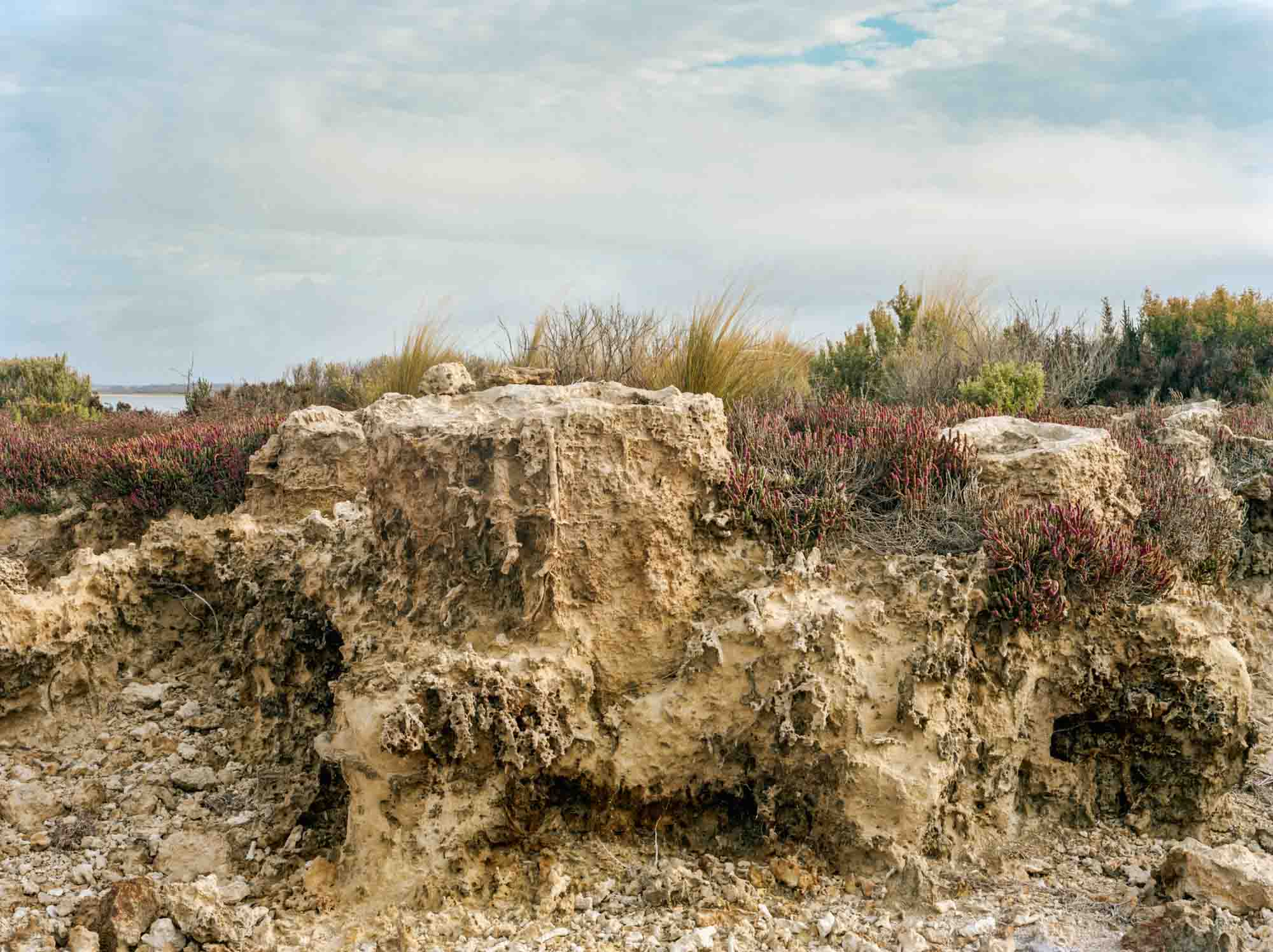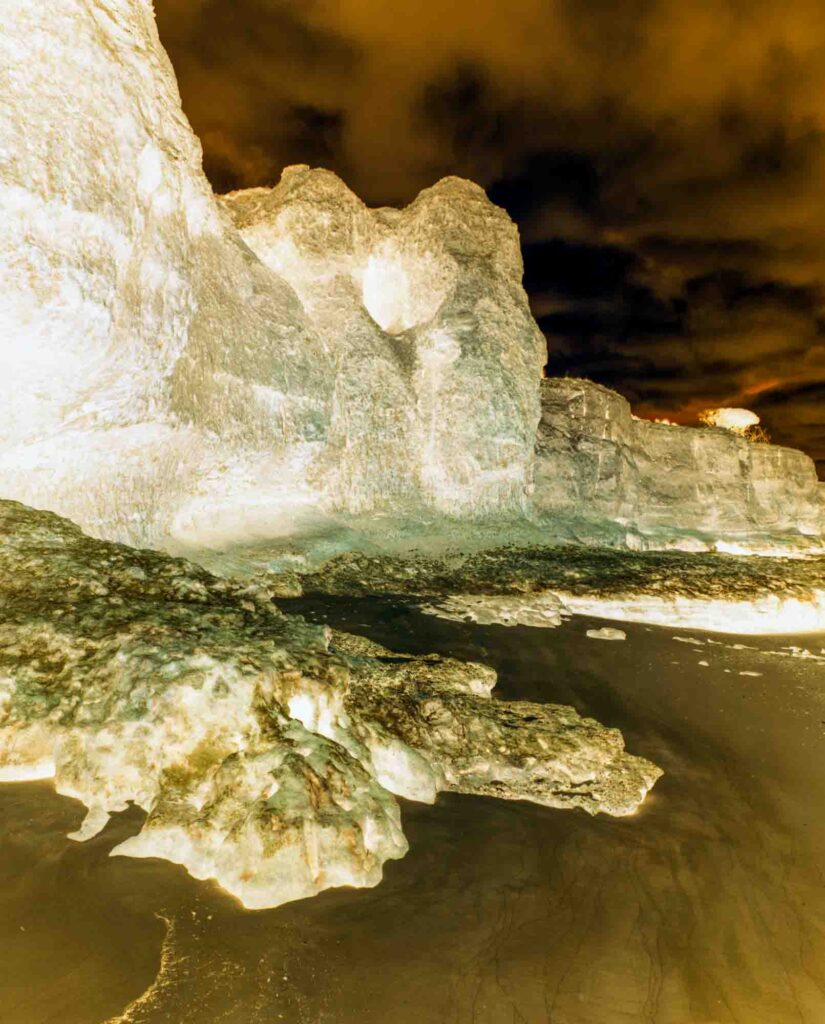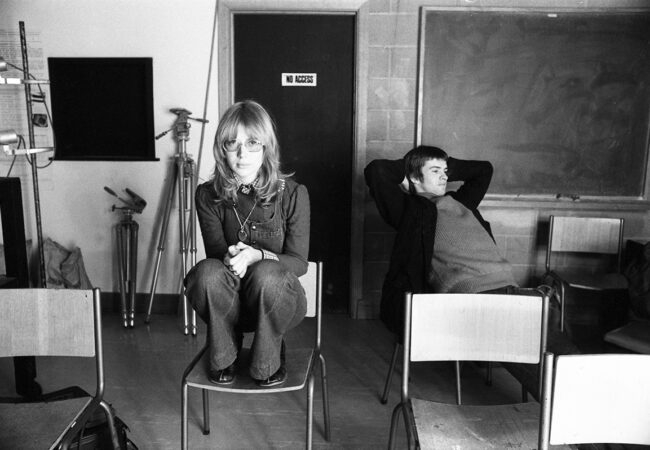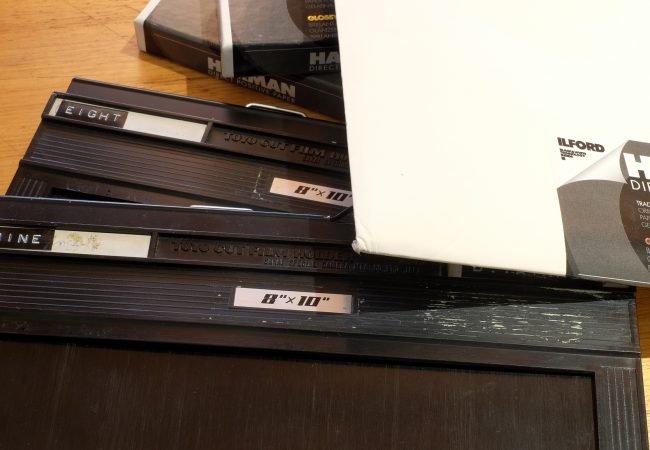
Reflective nostalgia, the network image, processing colour sheet film – Gary Sauer-Thompson
“It’s not just the meaning of the image that has changed – the act of looking does not have the same meaning. Now, it’s about showing, sending and maybe remembering. It is no longer essentially about the image. The image for me was always linked to the idea of uniqueness, to a frame and to composition. You produced something that was, in itself, a singular moment. As such, it had a certain sacredness. That whole notion is gone …. The culture has changed. It has all gone. I really don’t know why we stick to the word photography any more. There should be a different term, but nobody cared about finding it.” Wim Wenders, 2017.
Wim Wenders is referring to the decaying Polaroids and analogue photographs in his book Written in the West that were taken as a preparation for the film Paris, Texas in 1983. The photos were made for the specific purpose of exploring the American West to learn about its colour and light. Wenders observed that this mode of photography, which had been an integral part of everyday life, was very much a body language, and it had produced something that lasted by shifting the random process of looking around into something more substantial. That time has now gone. Today people take photos on their mobile phones, only a few look at them, and they usually don’t make prints. This is a very different photographic culture to that of Written in the West.
Wenders is right about this cultural transformation. Analogue photography is a minor current within the contemporary digital, visual economy of Google, Facebook, Youtube, Instagram and TikTok. This social media present is one of a flow of digital images, millions of circulating poor quality images that whizz around the internet, minimal attention spans, the primacy of novelty and machine learning. It is a world of computer-computer interaction, where hyper-saturated colour images are involved in a multitude of computational processes hidden behind their photographic appearance on the screen. In this digital world of the networked image the art gallery/museum anxiously defends its traditional realm of a canon of securely anchored and presented images created by professional artists as exceptional individuals.
Wenders’ view is nostalgic in the sense of a desire to return home to, and a longing for, the analogue, photographic culture of Written in the West. Wenders’ nostalgia for this world now gone emerges from his dissatisfaction with the radical techno-cultural changes in contemporary life and visual culture that have radically changed the ontology of the photographic image. This ongoing process of change to the visual field is being driven by the fibre-optic cable, thinking machines, algorithmic processing, big data and vast computational speeds. Wenders’ nostalgia consists of being between a return home to the world of the analogue past alongside a simultaneous recognition of its loss and its irreconcilability with the present.
This nostalgia about analogue photography is an undercurrent of contemporary photographic culture. It surfaces in a sense of foreboding with the ever increasing price of film and the Kodak spiral: the price of film increases, reduced numbers of photographers buy the film, the price increases, less photographers buy the film etc etc. 8×10 colour film is now very expensive to use. In Australia the numbers of the commercial labs that have the capability to process large format colour sheet film are decreasing: Michaels in Melbourne has closed followed by the Work in Process Lab. Vanbar only processes 4 x 5 E6 and C41 4 x 5 colour. There is also a decline in the quality of processing colour sheet film due to the deskilling of the lab technicians.


The sense of foreboding is one of the practice of large format colour format becoming increasingly difficult in Australia. Its future options look to be either to process large format colour sheet film yourself (DIY), or to send the sheet film to a commercial lab in another state (eg., Rewind in Sydney, NSW) to be processed. Digital technology is opening up options for large format photographers as it is now possible to have the movements of large format cameras with a medium format digital camera through using the Cambo Actus or the Swebo TC-1 technology that a Fujifilm GFX 100 can lock into. This digital technology with its data-driven image is the future of the photographic, with this cultural revolution opening up new ways of understanding photography as the networked image and its computational simulation.
Making the switch from a large format film camera to the high end, medium format digital cameras is still financially out of reach for many, and so it still makes sense to continuing using colour sheet film. Given this financial constraint those using the commercial labs to process their colour sheet film are in a holding pattern. Their out-of-fashionness is a hanging on by buying colour sheet film overseas whilst hoping that the quality of the lab processing sheet film doesn’t decline further than it already has in Australia. The term remanence (to remain) describes this hanging on in a situation where the technology of analogue photography is obsolete and the computational mode of digital image production is dominant.
This situation indicates that we are near the top end of the S curve of technological disruption of Tony Seba, the Stanford University futurist. Seba’s account holds that disruption happens when new products and services create a new market and, in the process, significantly weaken, transform or destroy existing product categories, markets or industries. His basic argument is that a new product is technologically superior but initially more expensive than competing products in the mainstream market. In time, however, the cost of the product is lowered until it becomes less expensive than incumbent products whilst improving its quality or performance. This is certainly the case for a full frame digital camera compared to a 35mm film camera, and it is only a matter of time before digital medium format equals the quality of 4 x 5 colour sheet film. The inference from Seba’s disruption framework is that the historical period of mechanical, analogue photography, which was aligned with representation and objective truth and had the status of an aesthetic medium of subjective expression, has passed along with the culture of industrial capitalism of which it was a central part. It has been replaced by a digital world where the photographic has been transformed into the networked image.
The undercurrent of nostalgia for an obsolete, analogue photography is not simply a longing for what has gone as it is grounded in the present. The digital technology disruption has destroyed the film camera industry, but Seba argues that the process of technological disruption does not always imply the destruction of an existing market. Film photography continues as a niche market with its undercurrent of an outmoded aesthetics and technology associated with an interest in the analogue, the archival, the obsolete and pre-digital modes of communication. There is the resurgence of film, Leica is re-making its obsolete M6 rangefinder film camera, Pentax is planning to make a new film camera, there are a wide range of firms making new field view cameras, and many photographers are working with alternative photographic processes. The pervasiveness of the nostalgic return to the outmoded,obsolete or discarded technology is now a deeper undercurrent than when it was noted by Claire Bishop in her “Digital Divide: Whatever happened to Digital Art” over 10 years ago.
A niche market implies limits to the presence of the outmoded in a digital culture. The resurgence of film is mostly for 35mm and 120 colour film rather than large format colour sheet film, and no one is making new lenses for the large format cameras. As colour film becomes ever more expensive the economics of processing sheet film by the commercial labs means that it is not commercially viable for the labs. Film — including 35mm and medium format —- hasn’t made business sense for these labs in a couple of decades. For instance, Atkins Lab, which is the only commercial lab in Adelaide, stopped their E6 processing because not enough film was coming through the door to make it financially worthwhile for them to repair their E6 machinery. Nor is there enough colour sheet film being exposed in Australia to keep a boutique lab going financially. These limits indicate that it is necessary to start to be reconciled to the end of commercial labs processing colour sheet film.
This is an uncertain period in Australia as we do not know how long it is worthwhile to continue to expose and process large format colour film, given its rising prices; or how long the commercial labs will continue to process colour sheet film. Nor do we know how long film technology is sustainable when the algorithms pluck a few data packages out of the data flows and give them a visual form that resembles what we used to call ‘a photograph’. In this context being reconciled takes the form of keeping a keen eye on the development within the disruptive digital technology, continuing to use colour sheet film, and investing in medium format digital cameras. Reconciliation also means accepting that photography has become a continuous process of re-shaping visual forms out of flows of data within computational networks.
Some view camera photographers argue that this situation only applies to those large format photographers who use commercial labs to process their colour sheet film and to make their prints. Many large format photographers are not in this situation, as they process their own film and make their own colour and black and white prints, using the Jobo system. Jobo’s one-shot processing, which offers very precise film and picture development in a digital world, continues the wet darkroom tradition of analogue photography and the photographic medium, reconnects to the craft and the artisan as the means to create new images. Simon Reynolds in Retromania makes a distinction between vintage and retro: the former refers to an interest in the actual technologies of the past whilst the latter refers to the simulation of past styles (eg., Fujifilm’s film presets in its various digital cameras). The vintage is the continuation of the wet darkroom ethos of analogue photography as techne as it maintains the integrity of this tradition, along with its history, conventions and culture.
This objection overlooks the depth/breadth of the nostalgia for analogue’s pictorial syntax. It is a mourning for what has been lost by those whose photographic identity is based on a historical investment in the large format cameras, lenses and tripods of the industrial age. This mourning is not just being reconciled to the loss in quality, the deskilling of the processing capacity of the commercial labs; or the increasing expense of large format colour film. The process of conscious mourning is one that reconciles loss through reflecting back on memories of the comfortable past, whilst being dislocated in the unceasing change in the present. It is a mourning for the past world of an analogue, photographic paradigm that was built on the assumed solidity of the unique image as a truthful representation of a stable world. It is a yearning for a different time coupled to a ‘desire for indexicality’ with ‘a retrospective fondness’ for the “problems” of decay and generational loss that analogue posed.
The mourning is rational as our contemporary digital culture is a paradoxical one that is characterised by a retro or vintage aesthetics functioning as a counter response to 21st century digital photography. Analogue nostalgia can be understood as expressing the resurrection and restoring things how they used to be with this desire emerging from a dissatisfaction with the ongoing process of digitisation. When it takes the form of a retro style (black and white imagery) nostalgia has a dual function of past and present. Though a retro photography appears as if it is stuck in the past, it has a living presence within the operational logic of a computational, digital culture.
The nostalgia for the pastness of analogue photography as it is reframed by digital culture is more than an aesthetic style, or the memories of past films. Analogue nostalgia undermines the entrenched duality of either analogue or digital in photographic culture. Film photography has become a hybrid mode of photography in that it is both analogue (negative) and digital (jpeg) —- with both being co-constituted with software. This analogue-digital is a hybrid rather than vintage or retro. Scanning the negative with software is a weak spot as it reduces the quality of the negative and introduces imperfections. Rather than rejecting these imperfections in the pursuit of the ideal of the technically perfect image of vintage, analogue photography, these flaws are part of the hybrid work process. This hybridity in a paradoxical present suggests that there is a wide range of uses, effects and distributions of the analogue nostalgias within a digital visual culture where networked computers have the agency to create, read, sort and circulate images.

The hybridity perspective on the nostalgia for past photographic forms interprets it as being more than the refusal of digital technologies or a defensive response to contemporary digital photography. A hybridity perspective understands that the past provides an opportunity for reflection in the present about the digital remediation through incorporating analogue aesthetics premised on the materiality, the quirkiness, unpredictability, and the smooth colour of film. This remediation or correcting something that is deficient is a recovery of an aesthetics that reasserts imperfection, flaws and mistakes to counterbalance the logic of perfection that pervades the culture of digital photography. Nostalgia and progress in a digital culture are like Jekyll and Hyde — doubles and mirror images of one another — with the presence of analogue photography being a constellation of past, present and future.
The rationality of a reflective, analogue nostalgia also provides an insightful perspective on the paradoxical condition of photographic culture. It highlights that the contemporary condition of the photographic is premised on the paradox that when photography is being technically replaced by screens, algorithms and data flow, diverse photographic cultures are proliferating like never before. The perspective of all those directly or indirectly involved in the production, distribution and circulation of images is that the discourse of photography reaffirms the photographic image’s apparent place at the centre of visual culture. However, it is data that is on our smart phones, digital cameras and computers; it is data we are uploading, scrolling, swiping, saving, sharing and printing. It is data which issues forth everywhere as the photographic is data’s current visual form presenting itself on our various screens.
The category of the photographic then – and, with it, its traditional language, rhetoric, conventions and cultures – currently masks the reality of the data-driven network image and the current computational mode of image production. As it is difficult to accept that the cultural/historical form, tradition and culture of European/US photography is a medium made obsolete by its computational simulation, so the computational networked image is currently promoted in terms of the language, conventions and tradition of photography, which masks the new networked condition of the digital image. Paradoxically in a computational digital culture the photographic proliferates as the dominant language of the representational real. As this inheritance from tradition can distort our understanding of the photographic present, a reflective, analogue nostalgia can prioritise the openness and productivity of interpretation to emphasise how our understanding is partial and constantly changing.
A reflective analogue nostalgia interprets what is valuable in the traditional practice of large format analogue photography. It foregrounds the preconceptions formed within its tradition: eg., how the process of crafting an image with a large format film camera, both intertwines the embodied subject (photographer) and object (landscape) and brings her body into the centre of making photographs. Her boundaries do not end at the skin in her sensuous being-in-the-world, since her vision entails a bodily contact between viewer and the thing viewed. The colour of the light on the bush surround by other plants is experienced in a direct, bodily manner. This haptic aesthetic incorporates a context-dependent awareness that allows us to constantly discriminate between better and worse ways to see things — she judges that her photographic stance feels ‘just right’ or ‘appropriate’ in a given situation.
This interpretation brings the hidden biases and prejudices of digital photography into question. The embodied, pre-reflexive perception of large format film photography disrupts the conventional visual gaze of a disembodied seeing that masters and represents reality using AI technology, whose ever increasing automation and advanced processing of computational photography enframes the photographer. The former’s embodied orientation to the world counters the present historical ocular-centrism of a digital photographic culture by incorporating a situated embodiment into the technological enframing of digital, medium format photography. In doing so it nudges us to embrace a haptic aesthetic that is bodily situated in the moment.
This perspective on photography in a computational culture offers the medium format photographer a more comprehensive understanding of what the process of photography can mean. It shows that the critical reflection of analogue nostalgia is a valuable participant in the current dialogue about photographic language and cultures.
References
Claire Bishop, “Digital Divide: Whatever happened to Digital Art”, Artforum, September issue, 2012, pp. 434-442.
Svetlana Boym, The Future of Nostalgia, Basic Books, New York, 2001.
Andrew Dewdney + Katrina Sluis eds., The Networked Image in Post-Digital Culture, Routledge, London, 2022.
Andrew Dewdney, Forget Photography, Goldsmiths Press, London, 2021.
Martin Heidegger, The Question Concerning Technology and other Essays, trans. William Lovitt, Harper + Row, NewYork, 1977.
Ingrid Hoelzl + Remi Marie, Softimage: Towards a New Theory of the Digital Image, Intellect Books, Bristol, 2015.
Martin Lister, ed., The Photographic Image in Digital Culture, Routledge, London, 2014.
Laura U Marks, Touch: Sensuous Theory and Multisensory Media, University of Minnesota Press, Minnesota, 2002.
Maurice Merleau-Ponty, Phenomenology of Perception, trans. C. Smith, Routledge. London, 1962.
Simon Reynolds Retromania: Pop Culture’s Addiction To Its Own Past, Fabar and Faber, London, 2011.
Tony Seba, Seba Technology Disruption Framework, (https://tonyseba.com/wp-content/uploads/2014/05/STDF-booklet-binding-ok.pdf)
Wim Wenders, Written in the West, Distributed Art Publishers, New York, 2015.





Gary, thank you for writing such an informative article.
This article is important! It highlights the problems that all film photographers face. My favourite colour lab in the uk was Peak Imaging in my home city of Sheffield. They developed my Fuji colour 4×5 and made stunning Fujiflex prints. GONE.
Yes, even b/w large format film is expensive now but as long as I can get film, I’ll be totally independent of current trends by making platinum-palladium prints, which give me more pleasure than any photography I’ve ever done.
Amen
Hi Robert,
yep, large format film photographers are facing big challenges. Sorry to hear about the demise of Peak Imaging in Sheffield.
However, large format photographers are probably better placed in the UK than those in Australia, due to the larger population and the larger community of film photographers. I am presuming that more commercial labs with the capability to process and print colour sheet film will survive in the UK than in Australia. They will probably be situated in the UK’s global cities.
Great article, Gary. It encapsulates the discussions that you, David, and I have had in the past few years about the future of large format colour photography in Australia and more broadly. Hopefully, it starts a wider conversation.
Hi Mark,
thanks for the affirmation. It took ages to write the article which had its genesis in the discussions between you, David and myself. I still recall my initial shock when David talked about the future trajectory of those commercial labs who could process colour sheet film.
I tried to situate that trajectory within the context of the consequences of the digital revolution for photograph and its culture. The more I read the more that dramatic changes have taken place and that we still look at the new through the eyes of the old. The Unthinking Photography online hub associated with the Photographer’s Gallery in London is looking at the new from the perspective of the automated, networked life of the photographic.
Have a look at their website (https://unthinking.photography) when you have a spare moment. The new is a very different world to the one that we are familiar one of View Camera Australia, which in its own way is a part of the world of the networked image.
Thanks David. Glad to help support View Camera Australia.
Things have rapidly changed in the last decade with the ongoing digital revolution including photography’s ontology. We are living through these changes and we need to try and make sense of them.